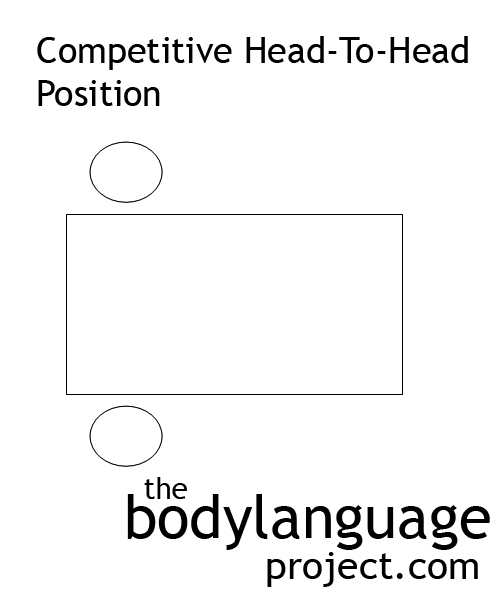The same types of relationships arise with round tables as they did with rectangular tables. When people wish to cooperate, they sit side-by-side, when they wish to be independent they keep one space open between each party, and when they wish to compete, they site at opposite sides. When it is desirable to maintain flow between three people equally, it is best to use a triangular sitting position at a round table which encourages discussion amongst all members equally. This allows eye contact between all members and discourages creation of rank and power.
Chapter 15 – Seating Arrangements
Circular Seating Positions
by Chris Site Author • March 6, 2013 • 0 Comments
When no leader is
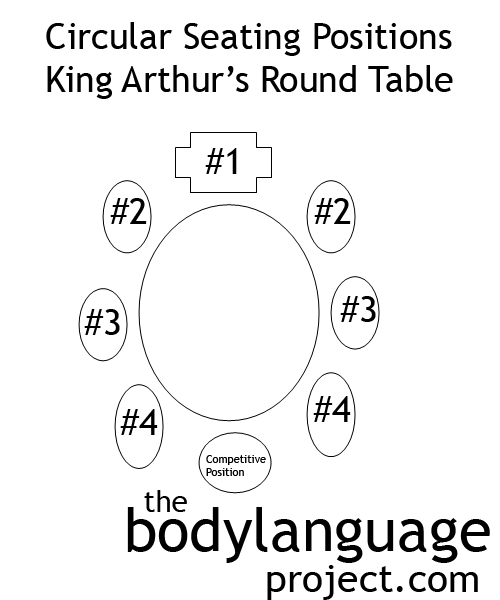
When a known leader is seated at a circular table, power trickles down as the relative distance increases. In this case #1 has the most power followed by #2, #3, #4 and finally the person who sits opposite. The person opposite finds himself in a unique situation of having to face the leader head-on!
present, round tables can be used to create informal settings unlike rectangular tables that are used to conduct work or to reprimand employees. In offices, round tables are usually a place to relax and converse or to drink coffee. Smart offices will use these areas to build alliances with potential clients, especially timid ones, break down barriers, and create rapport. Round tables can reduce pressure and build trust. Round tables also offers neat divisions or ‘pie shapes’ where each person receives the same amount of space or “territory” that collect into a common center. Square tables on the other hand, have territories that lack clear boundaries which can present their own power struggle.
King Arthur attempted to equalize authority and status amongst his knights with the “round table.” He felt that without creating a head of table, his peers would see themselves as more equal preventing quarrels. Previous to the round table, a medieval king usually sat at one end of the table, with the court jester facing him at the other end. The knights were seated at the two sides with the most important among them seated closer to the king. What King Arthur failed to realize with his round table, however, was the trickle down effect where those sitting to his immediate left and right held the next level of power due to their proximity to him. As one was more removed from the King, their level of status diminished likewise until finally reaching the furthest party. Unfortunate for this person, he faced the King directly putting him in a competitive arrangement! Ironically, and counter to his initial assumption, the round table can still present difficulties in creating positive outcomes especially where a definitive leader is present.
Square Tables
by Chris Site Author • March 6, 2013 • 0 Comments
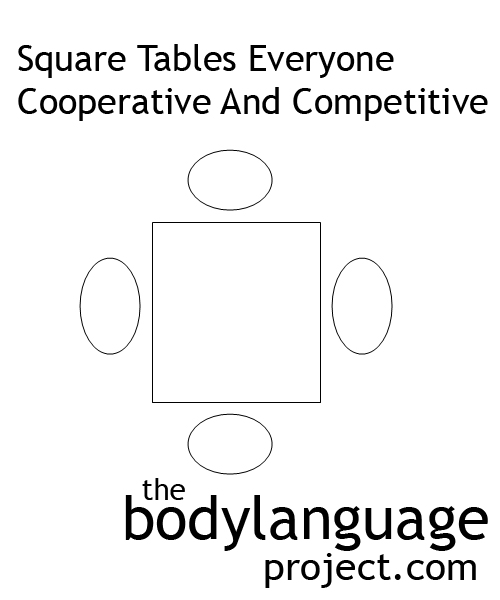
In a square table seating arrangement, each person is in a competitive (head-to-head) position and a cooperative (kitty-corner) position. This can present an interesting situation.
Square tables present an interesting situation. If we draw on what we know about rectangular tables we know that people who sit face-to-face are in a competitive position and those to our rights and lefts are in cooperative positions. Thus, everyone is equally competing and cooperating with someone at the table completely leveling the playing field. Square tables are great for quick meetings because of this dichotomy.
Bridge is an interesting game played on a square table. In the game there are four players in two fixed partnerships. The partners sit facing each other. It is the tradition to name the players according to their position at the table. They are called North, East, South and West. North and South are partners playing against East and West. In this card game, partners are not allowed to convey information to each other by talking, gestures or facial expression. The intent of the game is to exchange information by the choice of bids or cards played, but how well does this bode with the information we know about seating arrangements? The game has done well to prevent partners sitting next to each other preventing close quarter exchanges that might go unnoticed. However, it does allow partners to face each other head-on exposing their full fronts to each other and also prevents opponents from gaining the same view. While partners aren’t permitted to use any language whatsoever to exchange cues, being students of body language and aware of it’s proficient and pervasiveness might expect something different from the game whether or not it’s ever detected. Naturally, you’ll draw your own conclusions!
Leadership Positions And The Head Of The Table
by Chris Site Author • March 6, 2013 • 0 Comments

When no leader is present, the group will attribute leadership to whomever is sitting at the head of the table. Power trickles down from the head of the table toward the opposite end. Thus #1 has the most power, #2 the next most and so forth.
Not surprisingly, in studies looking at leadership, it was found that the most dominant person chooses the head of rectangular tables. Interestingly though, when no leader was present, leadership was attributed to the person who sat at the head of the table. Researchers Fred Strodtbeck and Harmon Hook in the early 1960’s found that during jury deliberations people at head positions tended to participate more often and had a greater influence on the decision making process, than people at the sides. This study overlooked whether or not leaders took up the positions though, but this is a likely assumption. However, in other studies it was found that a person’s status played a part in who chooses the head of the table. Those considered high class were much more likely than lower classes to sit at the heads of tables. Who knew money had anything to do with where we sit at a table!
Researchers attribute visibility and the ability to make eye contact with everyone as key features turning heads of tables into leadership positions. For example, one person sitting opposite three others would be seen as the leader, since they would be able to make eye contact with him, but not to each other. He would also be able to indicate his intentions better and therefore control the floor much easier. It should however be noted, that central positions at tables are also important in discussions since it permits ease of conversation amongst all participants through proximity. In other words, it’s hard to talk with someone from across the table, just imagine a “cartoonishly large” corporate sized boardroom! The exception to the head position as leader is when it exposes the back to the doorway. When this happens the head seat is a disadvantage since it leaves whomever open to surprise and attack.

When one person faces three, the person sitting by themselves are seen as the leader. His gaze is focused forward while his companions must head-turn to see and speak with everyone. In this case, #1 has the most power while each of the #2s share power.
Leadership shows a trickle down affect too. If the head of table is deemed the leader, than the person to their immediate side holds the next most powerful position, and so forth. In ancient times, the leader held the head of the table, with his lieutenants at his sides. The person who sits opposite the head, even today, is usually the most task oriented, whereas those sitting in the middle are usually affiliators, normally woman, who wish to interact with the greatest number of people and create active participation with everyone. Another feature of the Steinzor effect states that when a strong leader is present, people will direct comments to the person adjacent the leader more often because it avoids direct eye contact and confrontation with them, which is especially intimidating due to close quarters. When leadership was shared amongst all members, no strong patterns emerge and conversation basically happens freely.
Competitive Head-To-Head Position
by Chris Site Author • March 6, 2013 • 0 Comments
Legal television dramas popularize this head-to-head seating position. Here each party faces directly across from the other person usually with their allies to their left and right solidifying their flanks. Another words for this position is the “closed” seating arrangement because it isolates people with the use of the desk. In the “open” arrangement a desk is pushed up against a wall and presents no barrier to visitors since they can access every part of a person when meeting with them. Closed positions convey formality, distance and authority, defensiveness and even divisiveness whereas open orientations convey interest and comfort.
Even when competition isn’t directly encouraged, research finds that the closed position still becomes an issue because the table provides a clear boundary between each party. Despite this, studies show that it is a very common way to sit in for casual conversations and at restaurants. The reason expressed is because it easily permits the exchange of information, affords good eye contact by filling the other persons view, and turns each person into the centre of attention. Thus, while it can be a constructive casual position amongst friends and family, it doesn’t serve well with new associates or where there is a desire to break down existing boundaries.
Interestingly when larger groups meet in the competitive arrangement with many people facing one another across a rectangular table, it is most often the person to the front of the speaker directly across the table that talks next, and rarely the person to their side. This has been termed the “Steinzor effect” and was named after the researcher Dr. Bernard Steinzor in 1950 who first discovered the occurrence. The head-to-head position creates discourse and necessitates the person at their face to respond, moreso than any other at the table. This only adds to the negative data that stem from head-to-head orientations and why we should avoid it when we wish to accomplish something other than fight.
Research conducted in the mid 1970’s by psychologist Richard Zweigenhaft of Guildord College in North Carolina found that faculty that used their office desks as a barrier by placing it in between them and their students were rated less positively in general and where rated especially poorly as it related to student interaction. The study found that faculty that did this were also older and had a greater academic rank. Thus, it was likely their subconscious tendency was to protect and maintain their rank between themselves and their students. Therefore, when meeting with new clients or where competition is likely but undesirable, avoid sitting in the head-to-head position if possible and remove whatever barriers separate you and whomever it is you wish to build a relationship with. However, if the desire is to reprimand an employee or anyone else and the goal to set clear boundaries, the table-in-between-position can emphasis division, thereby enhancing the message further. It will be up to you to decide exactly what orientation will suite you best and this will be wholly dependant on the goal you wish to attain while meeting.
Independent And Opposite Position
by Chris Site Author • March 6, 2013 • 0 Comments
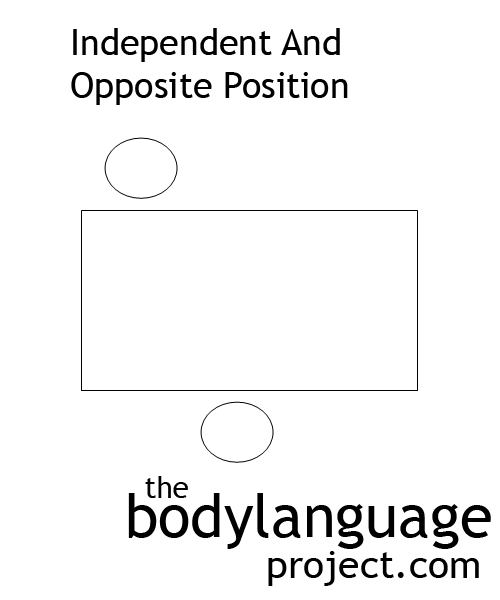
When people sit to do work but do not want to talk to each other, they will sit in the “independent and opposite” seating arrangement. We see this with strangers in a limited seating cafeteria or in a library when strangers share tables.
When the object is to show independence, than an opposite, yet diagonal seating position is recommended. We see this most often in cafeteria style arrangements when sitting by oneself isn’t possible and tables are filled with strangers but we still want the most amount of privacy possible. Students will choose this arrangement when studying separately in a library as it permits independent thought and separation avoids any direct eye contact should either party need a break from their work. When subjects were asked to sit and do work quietly in one study this was the most common seating arrangement. Usually the space between the parties will be evenly split and be occupied by handbags, books, papers and other belongings to reserve them from being taken up. Obviously this position should be avoided when cooperation and affiliation formation is has the reverse effect. The independent and opposite position when it is not expected creates hostility and shows indifference.
Cooperative Side-By-Side Position
by Chris Site Author • March 6, 2013 • 0 Comments
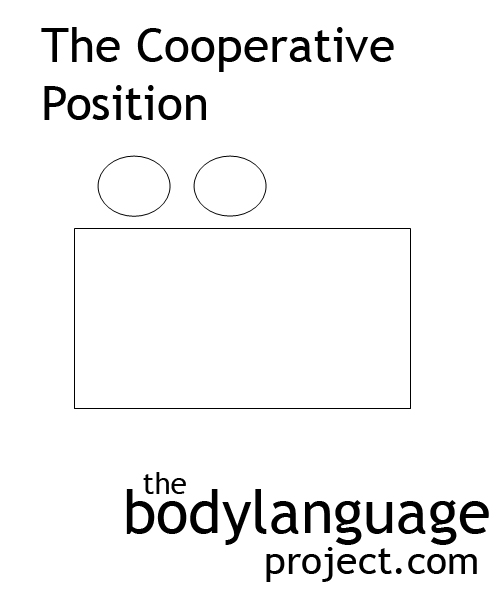
Chairs on the same side of the table is the “cooperative” seating arrangement as no barrier is present between the participants. It is the most open way of interacting.
The cooperative position contrasts the casual corner position with a side-by-side orientation on the same side of the table rather than kitty-corner or cross-corner. There are two possible arrangements for the side-by-side and the variants determine the level of connectivity and interaction between two people. When the chairs are facing forward, or toward the table, it slightly inhibits eye contact decreasing the level of sharing. This orientation shows that there is some cooperation but that it’s not complete. When chairs are facing forward in this manner, it is usually because it is assumed that people are already a part of your team and the two of you are facing off against another party.
A second orientation happens when collaborating on a project. Here, the chairs will (and should) be turned at forty-five degrees toward each other. This arrangement represents intimacy since there is no barrier to interfere with the sharing of information. Working on a common goal, a project or presentation are a few examples of when it’s best to use this arrangement. Intimate couples will also choose this position at restaurants except where moving the chairs about is not permitted. Other couples fail to see this and instead choose competitive arrangements as if they are on job interviews, or are facing off against each other in twenty questions!
There are times when sitting on the same side of the table can appear too intimate, as if invading someone else’s space. One can begin by taking up positions across the table and then finding an excuse to pass documents across it. After some time, moving to the other side of the table and sitting down to clarify the information provides enough of a reason to bridge the gap between people and being fostering intimacy.
Casual Corner Position
by Chris Site Author • March 6, 2013 • 0 Comments
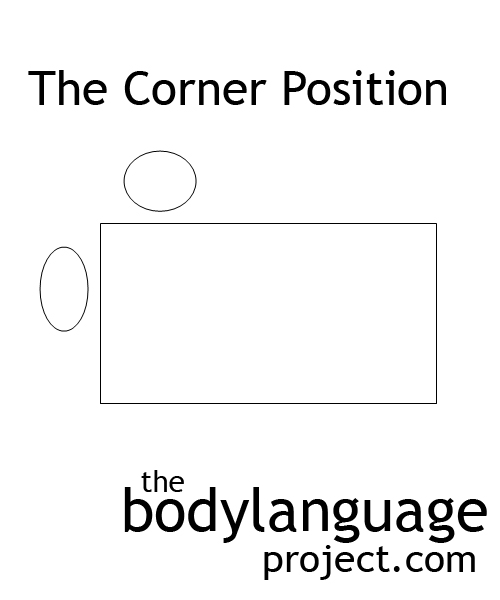
The “casual corner” seating arrangement is best in business as it the table provides are partial barrier, yet does not prevent people from interacting together effectively.
The casual corner position is most appropriate to preserve closeness between people, but at the same time offers a partial barrier. The barrier in this case, is the corner of the table. If chairs are directly facing the table, it avoids direct eye contact, but if preferred, the chairs can face one another across the corner of the table to make sharing of information easier. This seating position is unique because it neatly allows for independent thought, but the proximity still permits intimacy.
When presenting new information to a client or trying to “sell them”, this is the most preferred orientation. It is also a useful way to conduct an interview without coming off as aggressive or competitive. In studies when students were asked to choose a seating arrangement that permitted conversation, this was the most often chosen arrangement.
Early Research Into Seating Arrangements
by Chris Site Author • March 6, 2013 • 0 Comments
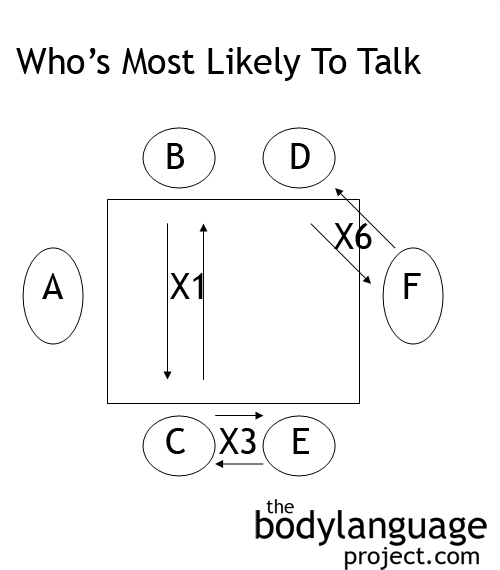
In a business setting people sitting kitty-corner (D and F) tend to talk 6 times as often as those sitting opposite (B and C). Those sitting next to each other (C and E) talk about half as often as kitty-corner but still 3 times as often as sitting on opposite sides of the table. The head position or leader position, tends to be spoken to the least.
One of the
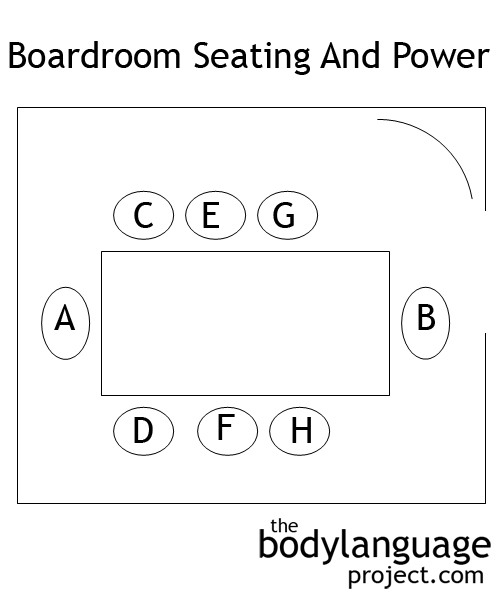
Boardrooms present an interesting power effect. In this case “A” is the head of the table because he benefits by seeing who might be entering through the door. “B” is also head of the table, but might be taken by surprise as the door is at his back. Power trickles down from the head of the table to “C” and “D” (flaking the head), “E” and “F” (flanking the flanks), and finally “G” and “H” who share the lowest rank..
earliest research studies was done by American psychologist Robert Sommer of the University of California in the 1950’s. He examined the effects of extensive renovations done to an old age home. The ward received new colourful paint, new lighting was installed, new chairs brought in and several small rooms were converted into one large day room. The furniture was also re-arranged to make conversations more likely amongst the patients by creating more face-to-face encounters. This rearrangement was based on what he observed daily in the hallways just outside the ward. Here, every morning the chairs were placed into straight rows, shoulder to shoulder, against the wall to make mopping easier. But if you entered sometime later in the day, you’d find them re-arranged into groups. It was the patient’s family members who moved the chairs to speak with the patients, rather than what the patient actually preferred themselves. From this observation and the fact that any changes in the ward were met with resistance it was obvious that the patients would resist the ward remodel. In fact, it was common knowledge around the home that every piece of furniture and chair “had its place.” A lot of which had been there, regardless of any logical or functional reason. The conclusions drawn from the study were less than positive likely because the study involved mentally handicapped patients. In fact, it was concluded that modification of furniture arrangements was not enough in and of itself to adequately increasing social interactions. However, drawing on his initial observations from the hallway, where regular visitors rearranged furniture, Dr. Sommer felt he was onto something important.
His future studies examined visitors interacting in a hospital cafeteria, students in classrooms, children in public, and a myriad of other social situations. He found that when conversing over a rectangular table, patterns began to emerge as a function of the shape and proximity speakers had to one another. In all arrangements it is the nature of the meeting which dictated the spatial “ecology”, he concluded. He learned that eye contact and distance are the two fundamental concepts governing how we sit, which in turn affects our ability to exchange information, speak effectively, or even draw lines of division. The next few paragraphs covers the ecology of round, and rectangular seating arrangements with respect to reasons for meeting, be it a casual meeting with friends, cooperative sharing of information, independent working or leadership purposes.
How We Know Why We Meet
by Chris Site Author • March 6, 2013 • 0 Comments
It should be immediately obvious what the true purpose is for meeting based on the type of seating provided. A formal setting that is boardroom-like with status icons means that serious business is at hand, whereas a couch with a coffee table signifies much less urgent matters. When we meet formally, relationship building is not the aim, more casual meetings build relationships, so we should either plan or act accordingly. If the boss calls the meeting, we should know what is up before we even get there so we know what to expect.
Seating arrangements are a big part in how the meeting will transpire. For example, facing one another means that ideas are divisive and that party’s are probably unwilling to change, or if desired we can even foster more competition by artificially creating this arrangement. Perhaps not useful under the average circumstance, but effective non-the-less for lawyers who wish to milk clients dry by stretching out legal disputes! Sitting at forty-five degrees and on the same side means that ideas are informal and group minded where cooperation is sought. Smaller tables create more intimacy and group building, whereas larger tables emphasis more independence and creativity. More of this is covered in the chapter on seating arrangements. For now let’s focus on possible hidden agendas with respect to how we sit.
There are three basic reasons for meeting, they are ‘affiliation’ to build group cohesion, ‘achievement’ to get things done, and ‘power’ to emphasis control. Who calls the meeting and who is in charge will depend on how the meeting will be organized. To go along with the three types of meetings, there are three types of people in business. They are the ‘affiliator’ the ‘achiever’ and the ‘power player’. The affiliator is interested in building relationships, they arrive early and make a point of checking in with everyone and making sure everyone is happy and taken care of. They smile often and make eye contact frequently. They will set up meetings to foster cooperation and will often stay behind to answer any questions. The achiever will arrive on time and won’t want to waste a minute. If he talks before the meeting it will be because it was important and he’ll sit closest the person with the highest rank. They often show up well prepared with note pad, fact sheets, and so forth. They keep time, don’t stray off topic and leave as soon as the meeting is over. The final type, the power player is someone that arrive slightly late, spends most of his time with other leaders, and will try to sit where he can influence the most people possible. This person will also interrupt others more often, and they will stay right until everyone has left so as not to miss something, or miss out on important decisions.
Paying attention to who is running the meetings will tell us the goals of the meetings since not everyone is upfront about their purpose. Each meeting should begin by assessing where they sit, and why, as well as the types of personalities they have. As leaders, we can also manipulate the strengths of those around us for our own success. For example, you can use the affiliator initially and at the end to build group cohesion, the achiever to direct the middle of the meeting to get things done, and finally employ the power player to identify any potential pit-falls or struggles within the group.


